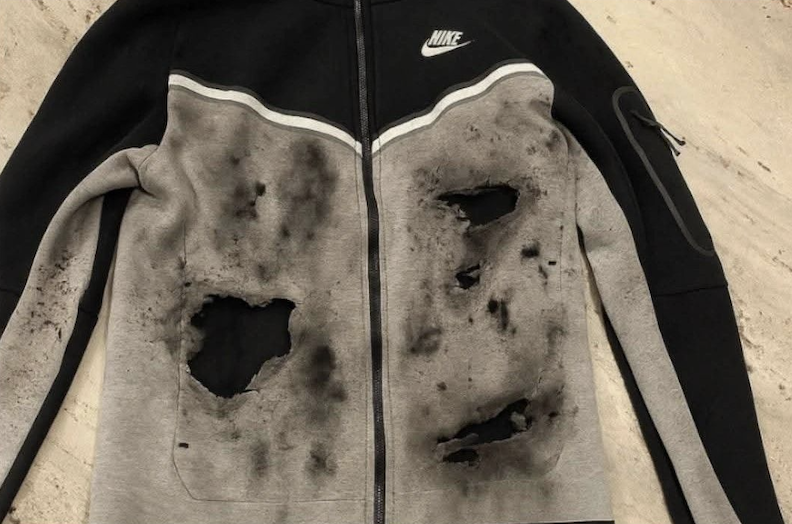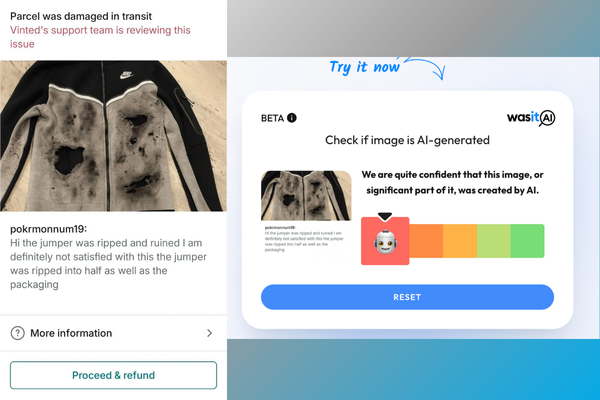The popularity of artificial intelligence has unlocked amazing opportunities – from creative design to faster content generation. But like every mighty tool, AI has also opened the door to new types of fraud. One of the most alarming trends emerging right now is the use of AI-generated images in damage claim schemes.
If you sell on marketplaces like eBay, Vinted, Vestiaire, or similar platforms, you might already be aware of the risks that come with buyer claims. Traditionally, fraud has meant sending back a different item or returning a counterfeit. Now, thanks to AI, scammers can go a step further: fabricating fake photo evidence of “damage” that never happened.
This is not a hypothetical problem. Reports are already circulating in online seller forums and groups where people share their experiences with fraudulent buyers. The pattern is always the same:
- A seller sends out an item in perfect condition.
- Days later, the buyer files a damage claim, attaching photos of supposed scratches, rips, or broken parts.
- The platform, relying heavily on visual evidence, sides with the buyer.
- The seller loses both the product and the money.
But here’s the shocking twist: many of those photos are not real. They’re AI-generated or AI-altered images, carefully crafted to look authentic and convincing.
Why AI Images Make Damage Claim Schemes So Dangerous
Traditional scams leave behind traces – a physical counterfeit, mismatched shipping labels, or clear inconsistencies. With AI images, those traces vanish. AI can add cracks, scratches, dents, or water stains onto a photo of an item within seconds, creating what looks like genuine proof of damage.
Unlike Photoshop, which often requires skill to look believable, today’s AI tools are so advanced that almost anyone can generate professional-looking edits. For sellers, this means:
- The evidence looks real even under close inspection.
- Platforms’ automated review processes accept the images at face value.
- Sellers are powerless to disprove the claims.
In short: AI is arming scammers with perfect fake evidence.

Platforms Need to Step Up
At the heart of this issue lies a simple imbalance: platforms currently trust images more than sellers. Buyers are often protected by default, while sellers are left with few options to defend themselves.
This worked in the past because images were assumed to be truthful. But with AI’s rise, that assumption is no longer safe.
If platforms want to maintain trust and fairness, they need to take proactive measures. That means:
- Integrating AI-image checkers into their review systems to verify whether an uploaded photo has been AI-generated or manipulated.
- Giving sellers a way to challenge suspicious evidence instead of automatically penalizing them.
- Educating their users about the risks of AI-fueled fraud, just as they once did with phishing and counterfeit scams.
Failing to act will lead to erosion of trust in selling platforms. Sellers may abandon marketplaces altogether if they feel unprotected, and legitimate buyers will lose access to trustworthy sellers.
How an AI-Image Detector Can Help
This is where technology needs to meet the challenge. Just as scammers are using AI to fabricate damage, AI can also be used to detect those fakes.
An ai-image detector works by analyzing the subtle signals in a picture – things the human eye can’t spot. These could be unnatural pixel patterns, inconsistencies in lighting, or the telltale fingerprints left behind by generative AI models.
By integrating these detectors directly into seller platforms, companies can flag fraudulent claims before they harm sellers. Imagine a buyer uploading a photo of a “damaged” handbag, and the system immediately alerts the review team: “This image shows signs of AI generation.”
That changes the entire game.
Introducing WasItAI: Protecting Sellers Against AI Fraud
At WasItAI, we’ve built exactly this kind of solution. Our mission is simple: to ensure the integrity of visual media. With our ai-image checker, sellers, platforms, and even individual buyers can instantly verify whether a photo is authentic or AI-generated.
We’re not just talking about generic detection. WasItAI is designed to handle the real-world scenarios sellers face:
- Damage claim schemes: Identify if photos of “scratches” or “cracks” were artificially added.
- Counterfeit product images: Check whether a buyer is using fake images to justify a return.
- Fraud prevention for platforms: Integrate our detection API to safeguard millions of transactions automatically.
For sellers, this means having proof on your side. If a buyer submits AI-generated evidence, you can challenge it with WasItAI’s verification results. For platforms, it means protecting the ecosystem from abuse and maintaining user trust.

The Bigger Picture: Why This Matters Now
The rise of AI image manipulation is not slowing down. Every month, tools become more powerful, easier to use, and harder to detect with the naked eye. What used to take hours of editing can now be done in under a minute – for free.
That’s why awareness is the first step. Sellers need to understand the risks, platforms need to acknowledge the problem, and everyone in the e-commerce ecosystem needs access to reliable AI-image detection tools.Scammers thrive on the assumption that they can outpace detection. But if platforms start adopting solutions like WasItAI, the balance of power shifts. Instead of sellers being defenseless victims, they gain a shield against fraud.
A Call to Action
The message is clear: damage claim scams powered by AI are not just a niche issue – they’re a growing threat to global e-commerce.
- Sellers: Protect yourself by using an ai-image checker whenever you face suspicious claims. Don’t let fabricated photos ruin your business.
- Platforms: Stop relying on blind trust in images. Integrate ai-image detectors to safeguard your sellers and ensure fair dispute resolution.
- Buyers: Be aware of the technology’s dark side and support platforms that take fraud seriously.
At WasItAI, we’re committed to being part of the solution. The future of online selling depends on trust, and trust depends on truth.
If you’re a seller, a platform operator, or simply someone who cares about fairness in digital commerce, now is the time to act. Don’t let AI-driven scams define the next chapter of online marketplaces.
Final Thought: AI has given us incredible tools, but with great power comes great responsibility. Together, we can make sure it’s used to protect, not to deceive. And with WasItAI, every seller finally has a way to tell reality from fabrication.
